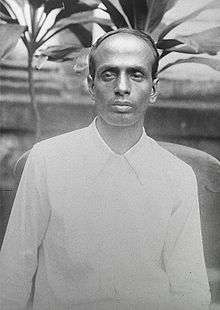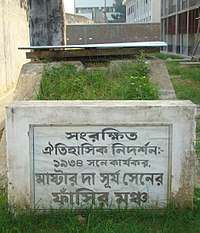Chittagong armoury raid
| Chittagong armoury raid | |||||||
|---|---|---|---|---|---|---|---|
 Surya Sen, leader of the raid | |||||||
| |||||||
| Commanders and leaders | |||||||
| Surya Sen | |||||||
The Chittagong armoury raid,[1] also known as the Chittagong uprising, was an attempt on 18 April 1930 to raid the armoury of police and auxiliary forces from the Chittagong armoury in the Bengal Presidency of British India (now in Bangladesh) by armed Indian independence fighters led by Surya Sen.[2][3]
The raiders
The raiders were members of revolutionary groups who favoured armed uprisings as a means to achieve India's independence from British colonial rule. They were inspired by the 1916 Easter Rising in Ireland and led by Surya Sen. However, they were ideologically influenced more by the Communists in Soviet Russia. Many of these raiders later became Communists. The group included Ganesh Ghosh, Lokenath Bal, Ambika Chakrobarty, Harigopal Bal (Tegra), Ananta Singh, Anand Prasad Gupta, Tripura Sen, Bidhubhusan Bhattacharya, Pritilata Waddedar, Kalpana Dutta, Himangshu Sen, Binod Bihari Chowdhury, Subodh Roy, Monoranjan Bhattacharya.[4]
The plan
Sen devised a plan to capture the two main armouries in Chittagong, destroy the telegraph and telephone office, and take as hostages members of the European Club, the majority of whom were government or military officials involved in maintaining the British Raj in India. Firearms retailers were also to be raided, while rail and communication lines were to be cut in order to sever Chittagong from Calcutta. Imperial banks at Chittagong were to be looted to gather money for further uprisings, and various jailed revolutionaries would be freed.
The raid
The plan was put into action at 10 p.m. on 18 April 1930. The police armoury (in Police Line in Dampara) was captured by a group of revolutionaries led by Ganesh Ghosh, while another group of ten men led by Lokenath Bal took the Auxiliary Forces armoury (now the old Circuit House). Some 65 people took part in the raid, undertaken in the name of Indian Republican Army, Chittagong Branch. They failed to locate ammunition but did succeed in cutting telephone and telegraph wires and disrupting train movements.
About 16 of the group captured the European club's headquarters (in Pahartali, now the Railway Office next to Shahjahan Field) but there were few club members present because of it being Good Friday. Upon learning of the situation, the Europeans were able to get the alarm out to troops, which the revolutionaries had not expected. After the raids, the revolutionaries gathered outside the police armoury, where Sen took a military salute, hoisted a national flag, and proclaimed a Provisional Revolutionary Government. The revolutionaries left Chittagong town before dawn and marched towards the Chittagong hill ranges, looking for a safe place to hide.[5]
A few of the members including Ganesh Ghosh, Ananta Singh and the teenagers Ananda Gupta and Jeebon Ghoshal were elsewhere, and almost captured at Feni railway station but managed to escape. Later they stayed in hiding in a house in Chandannagar.
Aftermath
After a few days, the police traced some of the revolutionaries. They were surrounded by several thousand troops while they took shelter in Jalalabad hills near Chittagong Cantonment on the afternoon of 22 April 1930.
Over 80 troops and 12 revolutionaries were killed in the ensuing gunfight. Sen dispersed his men to neighbouring villages in small groups and thus some escaped. A few fled to Calcutta while some were arrested. An intense crackdown on the resistance ensued. Ananta Singh gave himself up in Calcutta coming away from his hiding place in Chandannagar, to be close to the young teenagers captured and under trial in Chittagong. A few months later, Police Commissioner Charles Tegart surrounded their hideout and in the ensuing exchange of fire, Jiban Ghoshal was killed.
Some of the revolutionaries managed to reorganise. On 24 September 1932, Debi Prasad Gupta, Manoranjan Sen, Rajat Sen, Swadesh Roy, Phanindra Nandi and Subodh Chaudhary led by Pritilata Waddedar, attacked the European Club, killing one woman. But the plan backfired and police searched the absconders. In Kalarpole encounter Deba Gupta, Manoranjan Sen, Rajat Sen and Swadeshranjan Ray were killed while the other two, Subodh and Phani were wounded and arrested. During 1930-32, 22 officials and 220 others were killed by revolutionaries in separate incidents. Debi Prasad Gupta's brother, was sentenced to transportation for life.
The armoury raid trial
The mass trial of those arrested during and after the raids concluded in January 1932 and the judgement was delivered on 1 March 1932. Twelve of the defendants were sentenced to deportation for life, two received three-year prison sentences and the remaining 32 individuals were acquitted. The twelve deported to Andaman included Ganesh Ghosh, Lokenath Bal, (in 1932) sixteen year old Ananda Gupta, and Ananta Singh.
Capture and death of Surya Sen


The Chittagong revolutionary group suffered a fatal blow when Masterda Surya Sen was arrested on 16 February 1933 from Gairala village after a tip-off from an insider of the group. For the reward money, jealousy, or both, Netra Sen told the British Government that Surya Sen was at his house. But before Netra Sen was able to get his 10,000 rupee reward, he was killed by the revolutionaries.
Surya Sen along with Tarakeswar Dastidar were hanged by the British Administration on the 12th of January 1934 after inhuman torture in prison.[6]
Film adaptations
A Bengali movie Chattagram Astragar Lunthan was made on the Chittagong armoury raid in 1949. It was directed by Nirmal Chowdhury.
A Hindi movie, Khelein Hum Jee Jaan Sey was made on the Chittagong armoury raid in 2010. It was directed by Ashutosh Gowarikar starring Abhishek Bachchan and supported by Deepika Padukone. It was based on the book Do and Die: The Chittagong Uprising 1930-34 by Manini Chatterjee.
Another film, Chittagong was made in 2010 and released in October 2012. It was directed by Dr. Bedabrata Pain, a former scientist in NASA who resigned from NASA to make this film. Manoj Bajpai was the lead actor and played the role of Surya Sen.
References
- ↑ "70 years of Independence: How Communists kept pestering the British throughout the freedom struggle". The Indian Express. 2017-08-18. Retrieved 2018-01-30.
- ↑ "Homage paid to Surya Sen on his 84th execution day | Dhaka Tribune". www.dhakatribune.com. Retrieved 2018-01-30.
- ↑ "India's former president Pranab Mukherjee starts Chittagong visit". bdnews24.com. Retrieved 2018-01-30.
- ↑ P. N. CHOPRA, VOL - I. "WHO'S WHO OF INDIAN MARTYRS". Retrieved December 7, 2017.
- ↑ Chandra 1989, pp. 251-252.
- ↑ Chandra 1989, p. 252.
Sources
- Chandra, Bipan (1989). India's struggle for independence, 1857-1947 (Repr. ed.). New Delhi, India: Penguin Books. ISBN 9780140107814. Retrieved 29 June 2015.
Further reading
- Chatterjee, Manini (2000). Do and Die: The Chittagong Uprising 1930-34, New Delhi: Penguin, ISBN 978-0-14-029067-7.
- Bhattacharya, Manoshi (2012). Chittagong: Summer of 1930, New Delhi: HarperCollins, ISBN 9789350292129.
- Mukherjee, Piyul and Nivedita Patnaik (2016). The Last of the Rebels, Ananda and his Masterda. A teenager's Eyewitness Account of the Chittagong Uprising, Kolkata, Bushfire Publishers and Surya Sen Bhavan, ISBN 978-8193182123
